Ichinoseki Linear Collider Bulletin
ILCNews vol.15 Dec 2015
- Junior high students go on science field trip
- JC Science Camp “Ichinoseki Leader Children”
- Elementary school kids and their parents learn about the ILC
- Second Ichinoseki Science Cafe for 2015 held
- Summaries of other news
- Ichinoseki Lives Cosmopolitan (introduction of international residents in Ichinoseki)
- Notices
Junior high students go on science field trip
Junior high school students went on a tour of advanced research facilities such as the High Energy Accelerator Research Organization (also known as KEK from its abbreviation in Japanese) in Tsukuba City, Ibaraki Prefecture, from August 5th to 7th. The theme of the trip was “learning, thinking and conveying.”
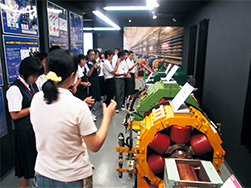
Students listen attentively to explanations
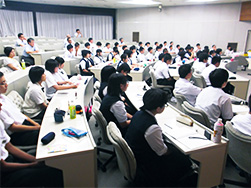
Lecture at KEK
Beginning in 2011, the annual trip is organized by Ichinoseki’s Board of Education for junior high school students to learn more about science and to train them to lead the next generation, by listening to researchers and getting up close to state-of-the-art science. This year, 62 third-grade students from 19 junior high schools in Ichinoseki City and the adjacent town of Hiraizumi took part in the trip.
As follow-up work, students submitted reports in September about what they learnt. Here we will introduce part of the reports by Shuuya Sasaki of Higashiyama Junior High, and Kotoha Sato of Ichinoseki Junior High.
“What I learned by taking part in the science field trip” by Shuuya Sasaki
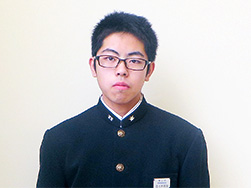
Shuuya Sasaki
We had two lectures at KEK by Associate Professor Junpei Fujimoto. In the first one, titled “Thinking in science,” we heard that molecules are made of atoms and there is an infinite variety of them, and that atoms consist of up quarks, down quarks, and electrons. After the lecture I kept thinking about something - what is science? Science is to learn about the shape of nature and the rules that govern it, in other words it is a pursuit of truth. The science I study at school is quite profound and can be difficult, but the more I understand, the more interesting it gets. I want to try researching about the things in our daily lives that make use of science.
The second lecture was titled “Let’s learn about the ILC” where we heard about the special features of the ILC and how it would work. When I thought again about how a tunnel 31 kilometers long could be built 100 meters underground near where we live, and a large-scale facility would research the beginning of the universe, I thought it’s something really great.
In this lecture I also learnt that accelerators can show us the hidden power of nature and the universe, and that what we can see is not all there is, thus the pursuit of this knowledge is important. From now on, when something interests me I’m going to try researching it until I understand it.
After participating in this field trip, I thought that researchers love science and are proud of their jobs. I hope to get a job that can help them, even if just a little bit.
“What I learned on the trip, and the future of medicine” by Kotoha Sato
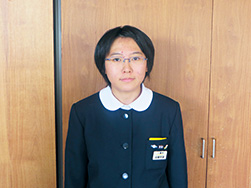
Kotoha Sato
Of the research facilities in Tsukuba we visited I am most interested in KEK, so I was able to learn things very useful for me. One of the things that impressed me was the high energy accelerator. I saw a real one up close and I was blown away. It was just so big, and there was a lot of equipment I hadn’t seen before.
The accelerator collides electrons with positrons, and analyzes the properties of particles and composition of molecules that come of the collisions. I was surprised to learn that these collisions are miniature versions of the Big Bang, and that it simulates the beginning of the universe. I learned that accelerators can help solve the mysteries surrounding fundamental particles, and my hopes rose that they might be built in my own hometown. I felt proud, and want to take part in efforts that will bring the ILC to Ichinoseki.
Another thing that impressed me at KEK was the Photon Factory - a synchrotron radiation facility which conducts experiments in life and other sciences. Research there is discovering the composition of proteins, which is useful in the improvement of drugs and the development of new drugs used to treat complicated illnesses. It really is state-of-the-art medicine.
When I heard the word radiation I thought it was a bit scary, but there are many things we can learn from radiation, and it is something that will help yet more people.
It was my first time to go to the advanced science city of Tsukuba. I learnt a lot and had many valuable experiences. I hope to use current state-of-the-art science and connect it with the future, and be able to help people.
JC Science Camp ILC “Ichinoseki Leader Children”
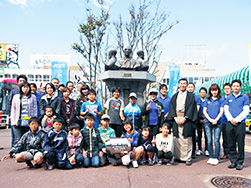
Sealing the time capsule outside
Ichinoseki station
Junior Chamber (JC) International Ichinoseki, led by Mr Ken Saito, held their “JC Science Camp ILC 2015” on September 5-6 as part of events this year marking the organization’s 60th anniversary.
The camp was held for kids to enjoy and feel the greatness of science and the universe, and raise their hopes and dreams for the future. 62 students in the fifth and sixth grades at elementary schools in the city took part in the two-day camp, visiting the High Energy Accelerator Research Organization (KEK) in Tsukuba and other research facilities.
By visiting state-of-the-art facilities, students learned more about science and furthered their interest in it. They made friends with kids from other schools in the city, and became more conscious of creating a new Ichinoseki.
Students later wrote messages for the future, such as what challenges they wanted to take, what they imagined Ichinoseki would look like if the ILC is realized, what kind of person they would be in 20 years, and so on. A ceremony was held on October 4th outside Ichinoseki station, at which the messages were put in a time capsule and locked inside the base of a statue of three important historical figures. The students then pledged for everyone to meet again in 20 years to open the capsule.
Elementary school kids and their parents learn about the ILC
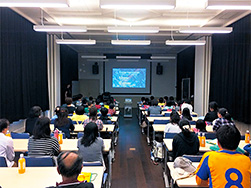
ILC talk at the Space and
Astronomy Museum
Fourth grade students at Okita Elementary School in the town of Daito in Ichinoseki’s northeast went on a trip with their parents to the Oshu Space and Astronomy Museum in neighboring Oshu City on August 29, to learn about the ILC and the universe.
20 students, their parents and teachers made up a group of 55 that took part in the excursion. A member of staff from Ichinoseki’s ILC Promotion Division gave a talk about the ILC and research facilities overseas.
The kids learnt that if the ILC is realized that many researchers would move from abroad to come here to live and that various facilities would be built, and became hopeful about future possibilities.
Second Ichinoseki Science Cafe for 2015 held
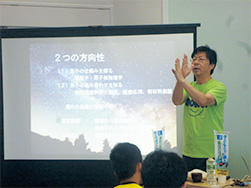
Associate Professor Fujimoto speaking at
the cafe
The ‘Ichinoseki Science Cafes’ are a place for enjoying talks about science with researchers and other specialists. The casual sessions are for people to become more familiar with fundamental particle physics and the scope of International Linear Collider (ILC) research.
The second Science Cafe for this fiscal year was held on September 12 at the Ichinoseki City Library, presented by Associate Professor Junpei Fujimoto of the Institute of Particle and Nuclear Studies at the High Energy Accelerator Research Association (KEK).
Associate Professor Fujimoto presented with a title of “Using the ILC to unravel the mysteries of the beginning of the universe,” and some 20 people from in and out of the city attended, including elementary, junior high and high school students, who learned more about fundamental particles and the significance of ILC research.
Associate Professor Fujimoto said: “Science solves the riddles of how our universe was made. The ILC will allow us to see fundamental particles that we haven’t been able to see. It’s anticipated that new particles will be discovered, and that we will learn more about the mysteries and hidden potential of the universe,” emphasizing the importance of ILC research.
Participants asked many questions such as “What is light?” “Why would the ILC tunnel be in a straight line?” “Why is the mass of fundamental particles different?”, and Associate Professor Fujimoto answered each in a way that was easy to understand.
News on the third Science Cafe for this year will be covered in the next issue of ILC News. Details about the fourth session and how to apply can be seen further down in this issue.
Summaries of other news
Dr Suzuki, president of Iwate Prefectural University, wins Breakthrough Prize
The Breakthrough Prizes are awarded by the Breakthrough Foundation in the United States, and honor researchers who have made important achievements in fundamental physics and other noted categories.
Dr Atsuto Suzuki, president of Iwate Prefectural University, was one of the recipients of the Breakthrough Prize in Fundamental Physics, for “the fundamental discovery and exploration of neutrino oscillations, revealing a new frontier beyond, and possibly far beyond, the standard model of particle physics.”
The Breakthrough Prize in Fundamental Physics was established in 2012 and this is the first time Japanese people have been awarded. Dr Takaaki Kajita - one of the winners of this year’s Nobel Prize in Physics – was also one of the recipients of the Breakthrough Prize.
ILC booth at the Ichinoseki and Hiraizumi Hot Air Balloon Festival
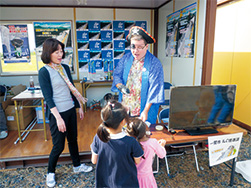
Date: October 10 and 11
Location: central Ichinoseki
An ILC booth was set up at the Ichinoseki and Hiraizumi Hot Air Balloon Festival 2015, where supporters of internationalization in Ichinoseki (Assistant Language Teachers in Ichinoseki) handed out ILC balloons and helped promote the ILC.
Ryoban Industrial Plaza staff visit Ofunato and Kesennuma
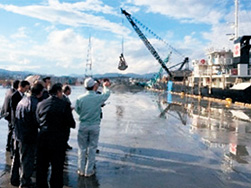
Date: October 30
Location: Ofunato City and Kesennuma City
Members of the Ryoban Industrial Plaza, a cross-industry organization chaired by Mr Yoshinori Kikuchi which promotes growth in manufacturing, visited ports in Ofunato City and Kesennuma City; the envisaged sites of where ILC apparatus would be brought onto land.
Members learnt about the capabilities of both ports, hearing from port staff on the depth of the waters and facilities such as cranes used to lift equipment from ships onto land.
New ILC banner on the front of the city office
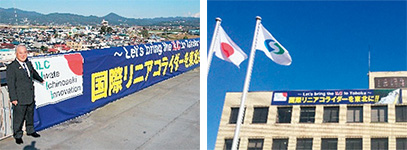
A new, colorful ILC banner was hung on the front wall of the city office in October. The new banner reads “Let’s Bring the ILC to Tohoku” with a similar message in Japanese, and features Ichinoseki’s ILC logo as well as an image of the ILC tunnel by Rey Hori.
Ichinoseki Lives Cosmopolitan
While working on making the ILC a reality, Ichinoseki is working on making itself a more international city. Here, we introduce international residents active in Ichinoseki. This time it’s David Hancock from the State of Connecticut in the U.S., who has lived in Ichinoseki since April and is an ALT teaching English at elementary and junior high schools in the city.
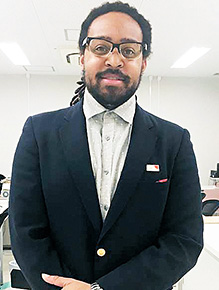
David Hancock
- Q: What are your interests?
- A: I’m particularly interested in technology, graphic design, supercars, billiards and horology. If I have a book in my hand or am watching YouTube, about nine times out of ten it will be one of those things.
- Q: Is there any place in Ichinoseki that you like in particular?
- A: One of my favorite places is Genbikei Gorge. The emerald green of the river, dango that flies by overhead cable from one side of the gorge to the other, nearby inns with hot springs. I will always remember my time spent at Genbikei.
- Q: Is there anything you would like to try with regard to children’s English education?
- A: If possible I’d like to take part in more ‘out of school’ activities as well. In the last couple of months I’ve been part of an English play organized by the Yamanome Civic Center, which was performed in front of the students’ families and later in front of exchange students at Tohoku University. It was a lot of fun.
- Q: Lastly, a word on making the ILC a reality.
- A: The ILC is a big opportunity for Ichinoseki and the Tohoku region. As a supporter of internationalization in Ichinoseki, I’ve enjoyed chatting with residents while contributing to understanding of the ILC, at the Ichinoseki Citizens Fair for example. I’d like to help out with PR in the future too.
Notices
Ichinoseki Science Cafes (4th session)
These sessions are a chance to chat with researchers and other experts over coffee and snacks while learning more about science and particle physics.
Venue: Ichinoseki City Library (Oomachi 2-46), second floor, “Sun Room””
Number of participants per session: about 30
Cost: 200 yen (students free)
Applications and enquiries: ILC Promotion Division, Phone: 0191-21-2111 (interior line 8647) or email: ilc@city.ichinoseki.iwate.jp
The fourth and final session for this fiscal year will be held as outlined below.
| Fourth session | |
|---|---|
| Date | Saturday, January 16th, 2pm-4pm |
| Title | Town Planning and the ILC |
| Intended audience | Residents of all ages |
| Speaker | Ms Tokiko Onuki, Campus Designer, Campus Planning Office, Tohoku University |
ILC Poster Contest
An ILC poster contest will be held for elementary school students, in conjunction with the Southern Iwate Regional Development Bureau. All applicants in Ichinoseki City will receive ILC goods! More details will be available soon on the city’s website and Facebook etc.
New mascot for the ILC
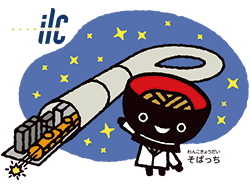
The Iwate Prefecture ILC Promotion Council has created a new mascot for the ILC - his name is ILC Sobacchi. Sobacchi is one of the “Wanko Kyodai” or Wanko Brothers, who are mascots for Iwate Prefecture. There are five brothers and Sobacchi is the leader or main representative of the bunch. The new ILC mascot features Sobacchi wearing a lab coat and behind him is an image of the ILC.
ILC Sobacchi was featured in the Oct 29 issue of “LC Newsline” – the newsletter of the Linear Collider Community – along with news of the ILC banner up on the Ichinoseki City Office. The issue can be seen here: http://newsline.linearcollider.org/2015/10/29/
![ILC News WEB[Ichinoseki City's ILC Promotion Site]](../common/images/h1.png)